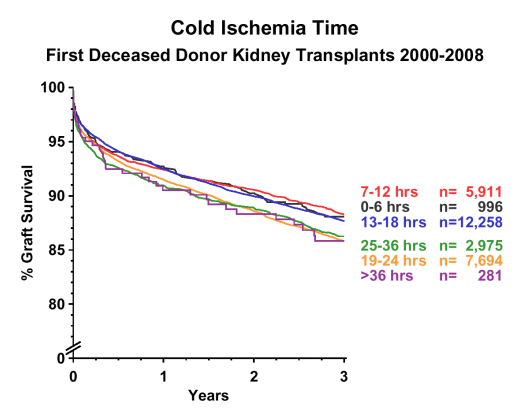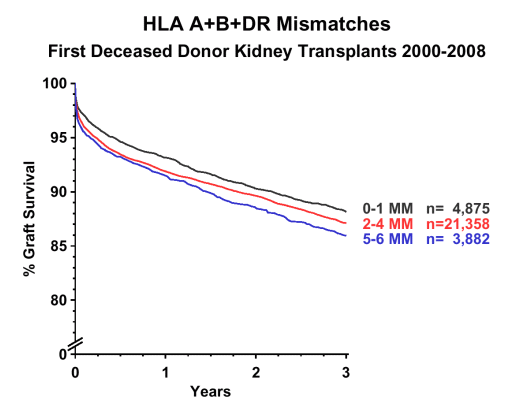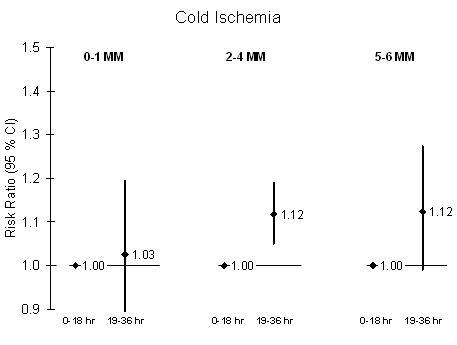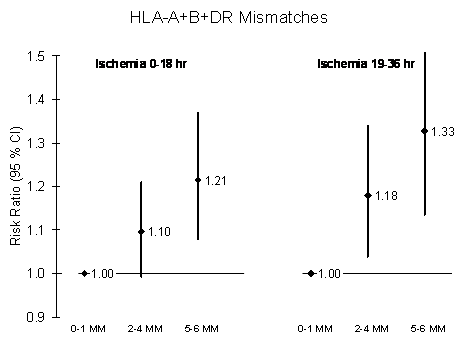
Figure 1
February 1, 2010
The relationship between ischemic kidney preservation time and the impact of HLA matching in renal transplantation is a recurring theme that commonly is misinterpreted. As a contribution to the ongoing debate, we have conducted an analysis of recent transplants (2000-2008) in 30,115 adult recipients younger than 65. "Problem donors" were excluded by limiting the donor age to < 60, and furthermore by excluding all so-called extended criteria donors. In other words, we analyzed transplants of "reasonably good" donor organs into "reasonably good" recipients.
Figure 1 shows the influence of cold ischemia time on graft survival. It is evident that there is a division at 18 hours. Shortening of cold ischemia to 7-12 or 0-6 hours did not improve graft outcome compared with the 13-18 hour group. We conclude that, with currently available preservation methods, ischemia up to 18 hours can be considered optimal. The survival difference between grafts with 0-18 hours or > 18 hours of ischemia was statistically significant (P < 0.001).

Figure 1
Figure 2 illustrates the univariate analysis of HLA matching, condensed into 3 groups of transplants: 0-1, 2-4, and 5-6 mismatches for HLA-A+B+DR. Increasing numbers of HLA mismatches are associated with a stepwise decrease in the graft success rate (P < 0.001).

Figure 2
The question remains how these two effects interrelate, whether one is more important than the other, and most importantly, whether the HLA effect can be eliminated by keeping cold ischemia to 0-18 hours. To answer this question, Cox multivariate analysis was employed, considering, in addition to ischemia and HLA, the following confounders: year of transplantation, geographical region, race, gender and age, original disease leading to endstage renal failure, preexisting diabetes mellitus, evaluation of recipient as a candidate for transplantation, preformed panel-reactive antibodies, and immunosuppressive therapy (CNI, IMPDH, steroids, mTOR inhibitors, antibody induction).
The impact of short or long cold ischemia on graft survival in kidney transplants with 0-1, 2-4, or 5-6 HLA mismatches is illustrated in Figure 3. Transplants with 0-18 hours of cold ischemia served as the reference group, and their survival rate was compared with that of transplants that had 19-36 hours of ischemia. In each of the three HLA mismatch categories, prolonged cold ischemia was associated with an increased risk of graft failure, ranging from a hazard ratio (HR) of 1.03 in the 0-1 mismatch group to HR 1.12 in the 2-4 and 5-6 mismatch groups, respectively, reflecting increases in risk of 3 % and 12 %, respectively, attributable to ischemia.

Figure 3
The reverse analysis, namely the impact of HLA matching within the two main categories of cold ischemia time, is illustrated in Figure 4. Here, the graft survival rate observed in transplants with 0-1 HLA mismatches was taken as the reference point i.e. HR 1.00. The impact of HLA was clear regardless of cold ischemia duration. In the short ischemia group (0-18 hours), 2-4 mismatches were associated with a 10 % increase in risk of graft failure, and 5-6 mismatches were associated with a 21 % increase in risk compared to 0-1 mismatches. Among transplants with 19-36 hours of cold ischemia, there was an 18 % increase in risk with 2-4 mismatches and a 33 % increase with 5-6 mismatches.

Figure 4
Altogether, we conclude that both ischemia and HLA match exert a significant effect on the graft survival rate. The increase in risk associated with HLA mismatching is greater than that associated with prolonged ischemia. Importantly, short ischemia does not eliminate the effect of HLA mismatches.
We hope that this analysis will contribute to a better understanding and appreciation of the relative effects of ischemia and HLA matching in kidney transplantation from deceased donors.
I would like to appeal to all CTS participants to support the serum and/or DNA studies. These studies were designed to address particular questions that require multicenter collaboration, simply because they address effects that are too infrequent for conclusive investigation at the single-center level. The results of several subprojects have already shown that important findings that would otherwise have remained unknown can be achieved through this approach. Your support will contribute to patient-oriented research and hopefully to future improvements in clinical transplantation. Please collect serum specimens and/or DNA or buffycoat samples from your transplant recipients for these studies. Samples should then be shipped to the study center twice a year at the pre-announced dates. Details can be obtained on the CTS website and we will be happy to provide additional information if you contact us. Please do not just watch the others take part, take part yourself and join this unique international collaborative research effort!
As usual at the beginning of the year, all global as well as center-specific outcome graphs have been updated and are available for viewing at www.ctstransplant.org. The new password is enclosed with the current mailing.
Thank you for your continued support of the Collaborative Transplant Study.
With best wishes,